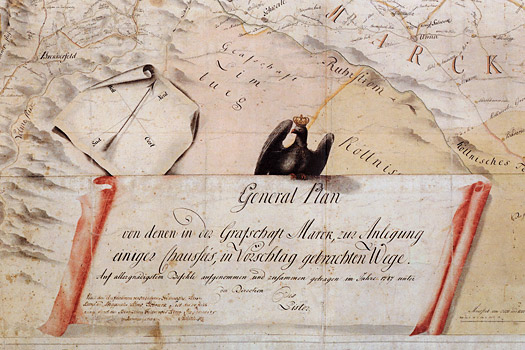
Preußischer Landesausbau in Westfalen
Als wohl bedeutendste preußische Impulse für die Verkehrsinfrastruktur und damit für die Steigerung staatlicher Einnahmen sind der Bau der Staatschausseen und die Schiffbarmachung von Lippe und Ruhr zu werten.
© Hellweg-Museum, Unna
Herrschaft zurück zur Auswahl
Prussians in Westphalia
Grand impulses from distant Berlin
Comparatively little architectural legacy was left by the 17th and 18th century Brandenburg-Prussian rule in parts of what later became the Ruhr Region. In 1609, after the deaths of the Duke of Jülich, Berg and Kleve, problematic succession brought about a power vacuum, until the treaty of Xanten in 1614 finally awarded Kleve and the county of Mark to Brandenburg-Prussia. Isolated in the West, these provinces had only secondary significance to the Prussian dynasty. Initiatives to expand development made a stronger impact in the Prussian heartland. When it became possible for example to recruit experts from Solingen in 1661, who brought with them specialised knowledge of manufacturing blades and knives, the intention was that they would be settled in the vicinity of Potsdam, not far from Berlin, but there was not only no coal, but also no water with sufficient down-hill slope. Eventually they settled in Eilpe (in today’s Hagen) and Wetter.
A strong centralist direction for all construction projects was first taken in the late 18th century, and strengthened after the Congress of Vienna, when the rest of today's Ruhr Region was transferred to the Prussians. Architectural monuments are included in this project because the Prussian rule over Rhineland and Westphalia had become no longer foreign; architectural impulses from distant Berlin do nevertheless find expression in them.
The salt works of (Unna-)Königsborn attracted the particular attention of the Prussian king's government, since seigniorage from salt guaranteed even higher revenues than hard coal. The little road construction work that had been carried out before 1815 and the work aiming to make the Ruhr navigable (1774 to 1780) were intended to promote the development of the salt works, and to make transportation of salt and coal easier. Among numerous technological innovations in Königsborn, soon to be adopted in other salt works as well, was the first steam machine of the western Prussian part of the land, the "Feuermaschine" ("fire machine") commissioned in 1799. One of the last, still preserved, architectural evidences of the salt works is the administrative building (Amtshaus) completed in 1817.
The leading town of Mark county was Hamm, first a garrison town, then, with the Kriegskammer and Domänenkammer (departments for War and the department for the Province), also seat of government. The administrators and officials based in Hamm (among them Karl Freiherr vom Stein) provided impulses, toward the end of the 18th century, for reforming economic and social relations within the entire province and hence also the Westphalian part of today's Ruhr Region. The Ostenallee is still a reminder of the special status of the city.
The most significant of the Prussian impulses for transport infrastructure and therefore the increasing of state revenues are the construction of the public highways and work on improving the navigability of the Lippe and Ruhr. But also the functional architecture of schools, churches, and vicarages reflects the Prussian presence, especially as many are based on typical designs of state-commissioned and local masters who were in turn controlled by the Higher Council of Architecture in Berlin, headed by Karl Friedrich Schinkel (from 1830).
Denkmale zum Impuls
Dortmund - Chausseemeile
Preußische Beamte leiteten unter der Führung des Freiherrn vom Stein die ersten ... weiter
Unna - Großes Hilfshaus in Hemmerde
Sogenannte »Hilfshäuser« an wichtigen Straßen und Wegen dienten den ... weiter
Witten - Ruhrschleuse in Heven
Die Ruhrschleuse in Heven gehörte zu 16 aus Holz gefertigten Anlagen, die zwischen 1776 und ... weiter
Hamm - Reformierte Kirche in Rhynern
Die Kirche der reformierten Gemeinde in Rhynern wurde zwischen 1666 und 1669 errichtet und ... weiter
Unna - Saline Königsborn
Die preußische Verwaltung baute 1817 für die Saline Königsborn ein Amtshaus. ... weiter
Hamm - Ostenallee
Hamm war im ausgehenden 18. Jahrhundert führende Stadt der Grafschaft Mark, in der ... weiter
Unna - Katholische Kirche in Hemmerde
Bei der katholischen Kirche in Hemmerde handelt es sich um den einzigen Kirchenentwurf von ... weiter
